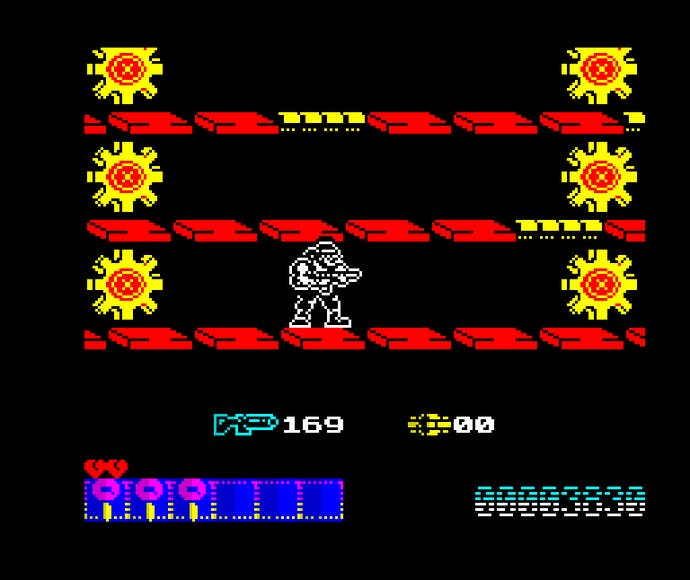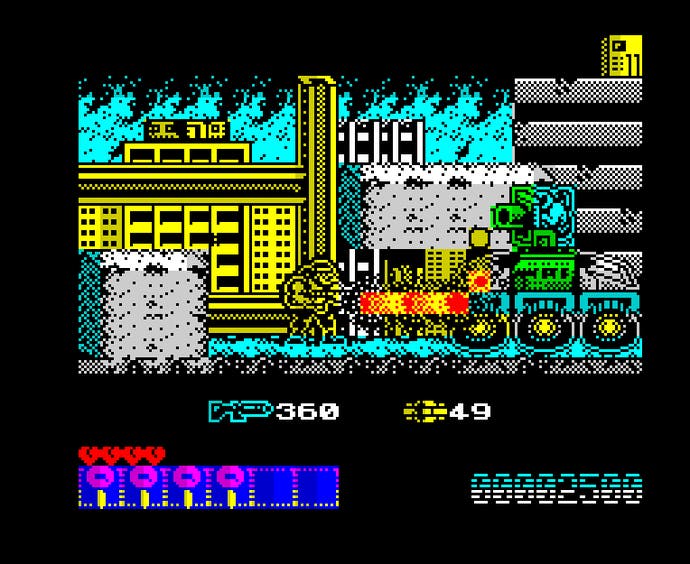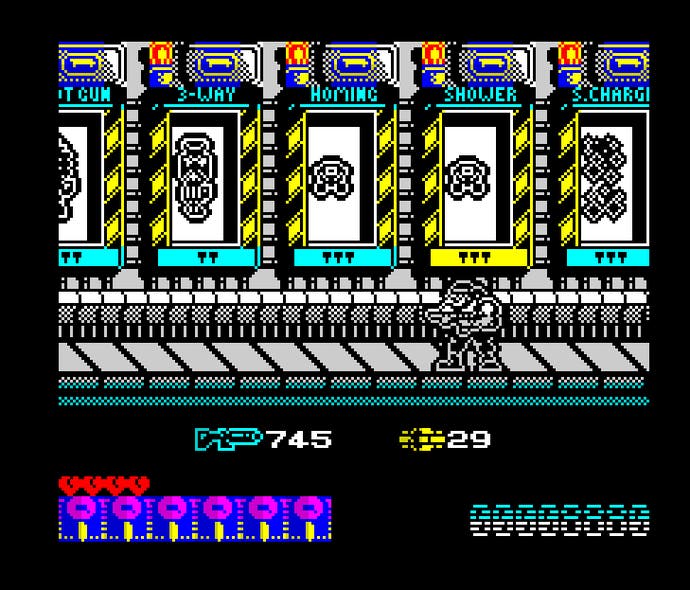Midnight Resistance retrospective
Speccy ops.
Midnight Resistance is the sort of old-school arcade game that dumps you right into the action. Press the fire button and you materialise mid-jump in the first level of its side-scrolling militaristic world, making landfall just as a blonde in a jeep vrooms past. If you orientate yourself quickly enough, you can catch a ride - that jeep will plough through the first few waves of enemy infantry, doing your super-soldier job for you. While not really a tutorial, it creates a window of chauffeur-driven downtime - literally, a welcome wagon - to help you get your head right for the mayhem to come. It's an unexpected dollop of calm before the sturm und drang. But I'm getting ahead of myself.
Right now, we're in a gaming straddle zone, one of those weird transitional phases where different generations of hardware co-exist. The Xbox One and PS4 might be waxing, but their immediate predecessors aren't waning just yet. Publishers keen to maximise potential profits (which is to say, pretty much all of them) put out their biggest games on as many platforms as they consider viable. That's why you could stage a five-a-side match using different formats of FIFA 14, and still have Android and iOS versions on the bench.

Things weren't that different in 1990. Back then, Ocean Software - the original gangstas of heavily-marketed movie tie-ins and canny coin-op adaptations - would release multiple versions of the same game across 8-bit and 16-bit platforms. Each port may have required a specialised coding team, but some of that financial outlay could be clawed back by reusing the same artwork and assets for packaging. The boxes and cassette inlays routinely spotlighted the handsomest version, with a standard disclaimer - "Screenshots taken from various formats"- that 8-bit owners came to instinctively distrust.
In 2014, it does seems faintly ridiculous that so many attempts were made to translate technically-advanced, purpose-built arcade experiences to home computers. From an objective point of view, the Spectrum ports of these sorts of splashy, blockbusting titles would be the "worst" - unsubtly rendered and downsized to cope with the lack of processing power. But at the time, it honestly didn't matter. Gamers are gamers, and such was the desire to believe that you were playing Operation Wolf or After Burner on a rubber-keyed 48k Spectrum, it was possible to complete the circuit by bringing your own imagination to the experience. It was self-hypnosis; a sort of mental upscaling, and a lie agreed upon.
It didn't always work. But there were times when it didn't work but it was still spectacular. On paper, the Spectrum was the home machine least suited to cope with the semi-realistic, Contra-esque vibe of Data East's Midnight Resistance, where wiry soldiers in fatigues staged firefights in a smoothly-scrolling world of muddy browns and industrial greys. The plot, such as it was, pitted you against a transgressive scientist who had kidnapped your family and whose private army was bolstered by his own abominable bio-mech experiments. Special FX, the studio tasked with developing Ocean's home versions, wisely rationalised the design from the outset. The arcade machine's gimmick - a rotating knob on the joystick that allowed you to shoot in one direction while running in another - was impossible to replicate, and the original two-player mode was dropped across all formats except the Amiga.

The Commodore 64 and Amstrad CPC versions could simulate the downbeat colour palette of the arcade and just about handle the scrolling, but the Spectrum version - created by coder Jim Bagley and artist Chas Davies - cartwheeled off in its own psychedelic direction. The slim, anonymous soldiers of the arcade were replaced with beefy, almost cartoonish sprites that brimmed with character. Skinny mortar positions became chunky gun turrets, and Davies ladled on the colour: this incarnation of Midnight Resistance was a riot of garish yellow, searing orange and more cyan than the human eye could reasonably be expected to handle. The exaggerated art direction even extended to the bullets, so pumped-up and heavily outlined you could keep track of them amid the optical exuberance.
Things were vibrant and often chaotic, but since Bagley adopted a push-scroll approach, it was possible to treat the majority of screens as discrete hand-eye coordination puzzles: memorise the attack waves, place your shots, scoop up the valuable keys to trade in at the end-of-level self-service gun-mart, then move on when you were good and ready. You couldn't always dictate the pace - one memorable section shunted you up the side of a gigantic redwood via inexorable lift platforms, requiring you to snipe jet-packed robots before a high altitude smackdown with a giant malevolent cog machine - but with no ticking countdown clock, it was generally less frantic than most arcade shooters of the period, despite the visual busyness.

Return to the Speccy version of Midnight Resistance now and it feels startlingly contemporary, a gaudy, grinning cousin to Hotline Miami, Far Cry 3: Blood Dragon and all those other self-reflexive retro-modern games that celebrate queasy neon. Back in the day, some players complained that it was too short, too easy; that once you'd got a handle on the weaknesses of the various mid-level and end-of-level bosses, you could breeze through it. Certainly, if you stuck to the most powerful ordnance loadout - a three-way gun that fired bullets the size of basketballs and a secondary "shower" weapon stuffed in your backpack that brought down an instant, screen-filling artillery hailstorm - you could take on a giant malevolent cog machine in your sleep.
But take just one hit and you would drop all your weapons and any collected keys required to purchase new ones, and if you didn't rush to retrieve them when your flashing soldier reincarnated, you'd be stuck with your standard-issue machine-gun until the end of the level. The controls were unwieldy, with your primary weapon always rotating through its eight-way field of fire rather than snapping to the direction you were moving in. Taking out an enemy jogging up behind you always took a little longer than you expected, often necessitating another mad scramble to retrieve your gear. These were minor niggles: compared to the camo-clad parade of soldier-on-a-mission run'n'gunners that were its nominal competition at the time, Midnight Resistance was an energised fever dream.
Was this jazzed vision just an unexpected byproduct of working within the tight constraints of 48k? Or did Special FX take their mindbending cue from somewhere else? It was only years later I learned the mad scientist antagonist was officially called "King Crimson". Perhaps Bagley and Davies were listening to 21st Century Schizoid Man on a loop during the final crunch, inspired to strange new heights by its proggy brilliance. In any case, their 8-bit cover version of Midnight Resistance managed to improve on the original, a towering achievement that still burns bright over two decades on.

